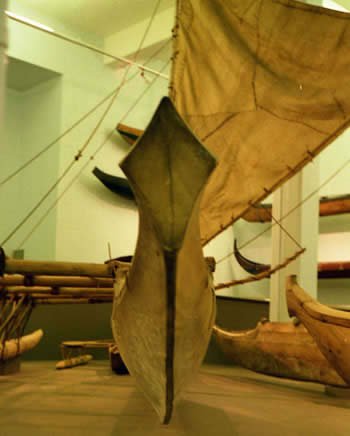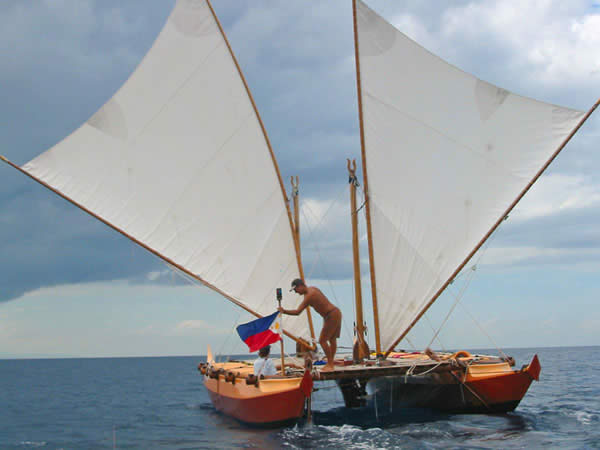The Tikopian Canoe rediscovered

In 1995 we were sailing the Pacific on a round-the-world voyage on ‘Spirit of Gaia’. Spirit of Gaia is a 63’ double canoe designed and built, in plywood/glass/epoxy by ourselves (James Wharram and Hanneke Boon) based on our studies of Pacific craft. She is our interpretation of what a true voyaging canoe would have been like, with only minimal Western adaptations. We have been designing Polynesian style double canoes/catamarans for 50 years.
When we arrived in Auckland in May 1995 we first saw a small Anutan canoe displayed in the Maritime Museum. This little craft intrigued us as it was the first V-eed Polynesian hull shape we had actually seen. This being a small paddling canoe the Vee shape was fairly wide and therefore different from the V-eed hulls we had been designing for years. However when we visited the Imperial Museum and discovered the ‘Sacred Canoe’, we were bowled over, as here was a canoe hull that was so similar to the hull shapes we had been designing that it made the hair on our arms stand up. James first drew a V-eed hull shape like this in 1957, convinced that this was what a true voyaging double canoe should look like, even though all Western thought at that time was that the Polynesians did not use V-eed hulls and their boats could not sail properly to windward. (See Two Girls Two Catamarans by James Wharram).
We were given permission to measure and photograph the Sacred Canoe (see front cover). When we drew these lines to scale and superimposed them on the lines of Spirit of Gaia, the similarity was uncanny. What it did prove was that the Tikopian canoe was a very seaworthy hull shape, capable of sailing close to the wind. This we had proven with our sailing of Spirit of Gaia.
The following year (1996) we sailed Spirit of Gaia into Melanesia and from Espirito Santo in Northern Vanuatu we headed for Tikopia. We spent 5 days on the island, met the Chiefs and showed our large voyaging double canoe to Chief Tafua and his family. We also had discussions with Chief Taumako, who’s ancestor had given the Sacred Canoe to the Bishop. We studied, measured and photographed all the canoes on the island and we realised that canoe building was no longer practiced and the people were loosing an affinity with seafaring. This visit made a deep impression on us.
Our studies of canoes in the Pacific and later in Indonesia and the Indian Ocean led us to get more and more involved with experimental Marine Archaeology. In 1997, inspired by the many small canoes we had studied in Melanesia, we designed and built a small/simple 16’ outrigger canoe built for under £200 from 2 sheets of plywood and tested on her the Polynesian Crab claw rig and steering paddle. Nearly 600 of these ‘Melanesia’ designs have now been sold all over the world and little outrigger canoes are now sailing in many remote parts of the world and people are rediscovering their sailing abilities. In 2000 we built a 21’ version, which we sailed both as an Outrigger Canoe and a Double Canoe. This possibility to take two outrigger canoe hulls and turn them into a double canoe is something we think was done in many Pacific islands. We believe that the more economical to build (in materials and labour time) outrigger canoes were used for voyages of exploration and adventure, but that when a migration was planned the canoes were turned into double canoes with greater deck area and better stability.
A reborn Tikopian double canoe
In 2003 we were asked by an idealistic American, Glen Tieman, who in the early 80s had built one of our 26’ Pahi designs and roamed all round the Pacific on her, to design a very simple Ethnic double canoe of around 35’, with just enough room in the hulls for someone to sit, cook and sleep. A sort of stretched out version of his previous boat and even more truly Polynesian.
This request led to the designing of the Child of the Sea ~ Tama Moana. When drawing her we ‘knew’ we had to use the beautiful Tikopian hull shape, this being the only original Polynesian hull shape capable of efficiently sailing to windward, and tried to keep within the Tikopian proportions and design parameters. She turned out at nearly 38’ long, with just sitting headroom in the hulls. The only change from the original design is that she is fully decked over the hulls, instead of just the bow and stern areas. This makes the boat a lot safer and dryer and we felt was a concession that could be made. Also she is a double canoe, though one of her hulls can be sailed as an outrigger. As a double canoe she is capable of making long ocean voyages. For full details of the design of Tama Moana see the study plan (available from James Wharram Designs).
The first Child of the Sea has now been built and is undergoing sailing trials in the Philippines. The second one, being built by Glen Tieman, is nearing completion. A third one has started building in Australia.







